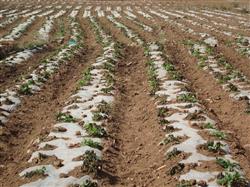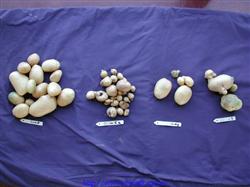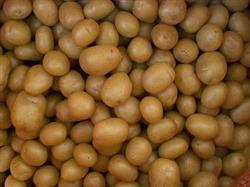Difference between Frost injury and Disease of Potato

Freezing injury: from the plant growth appearance, after the plant is frozen, the leaves and heart leaves have no disease spots, and the leaves are dark green. When the sun shines, the leaves appear to be wilted and seem to be cooked leaves. After 1-2 days, the leaf margin curled inward until withered, but the new leaves growing from the heart leaves had no symptoms of wilting. Disease: after the plant is damaged, the pathogen spreads upward with the growth of young buds, causing stem and leaf disease, forming a central diseased plant, which is transmitted by wind or soil. Obvious disease spots or spots appeared in the stems and leaves until the leaves of the plants turned yellow or even died. Effective methods to prevent and reduce frost injury are as follows: grasp soil moisture, timely irrigation, adjust soil water content and temperature, promote plant growth and enhance cold resistance. For potatoes cultivated with plastic film mulching, in addition to mastering reasonable irrigation conditions, it is more important that the opening of the broken film should not be too large after the seedlings are unearthed. When the seedlings grow to 10~15cm, the seedlings need to be pulled out of the film, and should be carried out in cloudy days, rainy days or when the shoes are not glued after irrigation, and the seedlings can not be broken at noon in sunny days, otherwise it is easy to cause freezing injury.
- Prev

Causes and Control measures of malformed Potato
Malformed potato is an important problem that some growers ignore while blindly increasing yield, that is, abnormal potato often appears in the process of tuber growth, especially in spring cultivation in the second season, because of high temperature and drought, the rate of deformed potato is high, which seriously affects the commerciality of potato and greatly reduces the horse bell.
- Next

Small whole potatoes are good for sowing potatoes.
Planting autumn potato is an effective measure to resist drought and make up damage at present. Autumn potatoes are usually sown from mid-August to early September. As the seed potato produced in most of the seed potato producing areas in China is too large, the cutting method of potato sowing is commonly used in order to reduce the cost and save the amount of seeds. But in recent years, 20-50 grams of small.
Related
- Where is it suitable to grow horseradish in China? it is expected to see the middle altitude horseradish in Alishan.
- How to prevent tomato virus disease reasonably? (Control methods included)
- Many people like to plant towel gourd on the balcony. What are the main points of this method and management?
- What crops can chili peppers be mixed with?
- Fertilization techniques and matters needing attention in Tomato
- What are the grafting techniques for peach seedlings in spring?
- Harm and control methods of root swelling disease of Chinese cabbage
- What are the pests of sweet potatoes? How to prevent and cure it?
- Symptoms, causes and Control methods of navel Rot in Tomato
- The cause of "Cucumber rotten bibcock" in Farmers' planting Cucumber and its Control Plan

